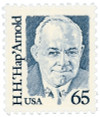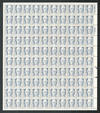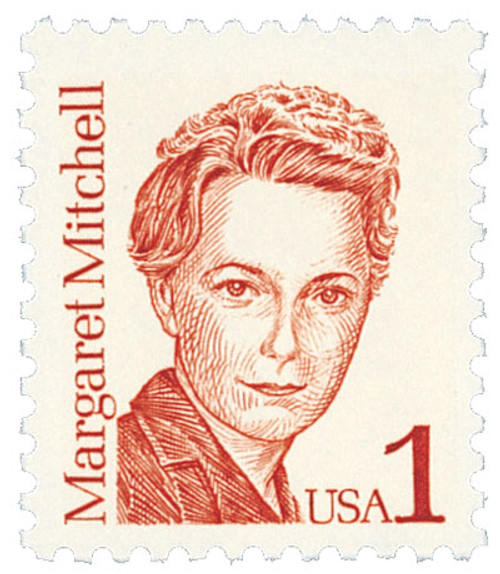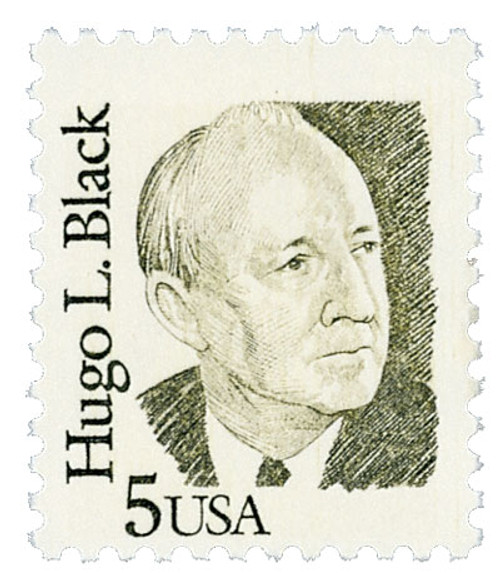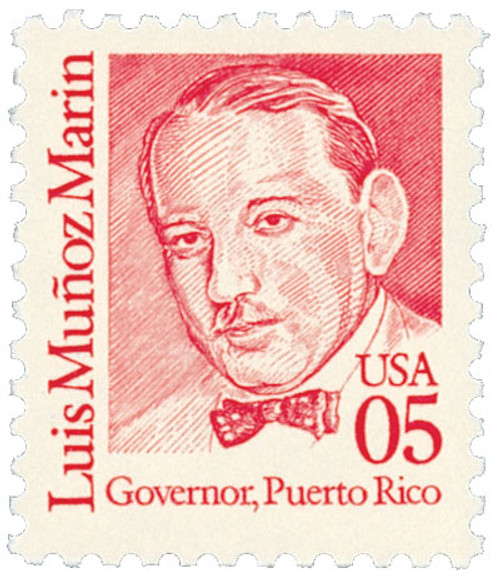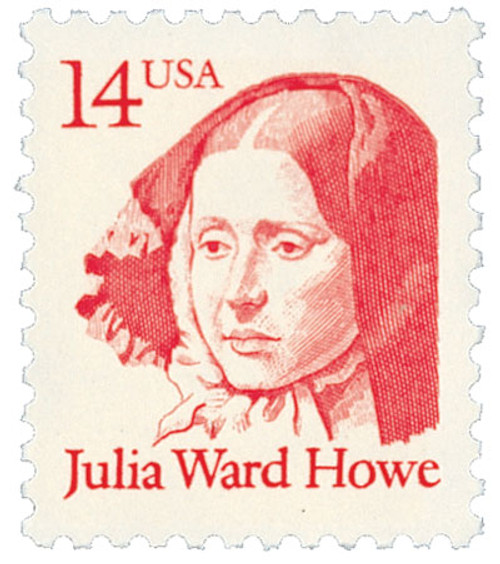
# 2191 - 1988 65c Great Americans: H. H. 'Hap' Arnold
U.S. #2191
1988 65¢ H. H. “Hap” Arnold
Great Americans
- Second 65¢ US stamp (after a 1930 Zeppelin)
- Last of the four five-star generals of the Army to appear on a stamp, even though he died first
Stamp Category: Definitive
Series: Great Americans
Value: 65¢, the first-class, three-ounce rate
First Day of Issue: November 5, 1988
First Day City: Gladwyne, Pennsylvania
Quantity Issued: 75,330,000
Printed by: Bureau of Engraving and Printing
Printing Method: Engraved
Format: Panes of 100 in sheets of 800
Perforations: 11.2 x 11.2
Color: Dark blue
Why the stamp was issued: To pay the first-class, three-ounce rate, replacing the 56¢ John Harvard stamp.
About the stamp design: Christopher Calle drew the portrait on this stamp, based on a photo provided by Arnold’s family. Said to be a family favorite, it showed Arnold in his later years, but didn’t include his rank insignia. Initially, Calle tried drawing different service caps on Arnold’s head, to include his insignia, but in the end, he left the caps off and instead added the circle of five stars to each collar tab. And it was verified that he had worn those stars before.
First Day City: The First Day ceremony for this stamp was held at the Gladwyne School in Gladwyne, Pennsylvania, Arnold’s hometown.
About the Great Americans Series: The Great Americans Series was created to replace the Americana Series. The new series would be characterized by a standard definitive size, simple design, and monochromatic colors.
This simple design included a portrait, “USA,” the denomination, the person’s name, and in some cases, their occupation or reason for recognition. The first stamp in the new series was issued on December 27, 1980. It honored Sequoyah and fulfilled the new international postcard rate that would go into effect in January 1981.
The Great Americans Series would honor a wider range of people than the previous Prominent Americans and Liberty Series. While those series mainly honored presidents and politicians, the Great Americans Series featured people from many fields and ethnicities. They were individuals who were leaders in education, the military, literature, the arts, and human and civil rights. Plus, while the previous series only honored a few women, the Great Americans featured 15 women. This was also the first definitive series to honor Native Americans, with five stamps.
The Bureau of Engraving and Printing (BEP) produced most of the stamps, but private firms printed some. Several stamps saw multiple printings. The result was many different varieties, with tagging being the key to understanding them. Though there were also differences in perforations, gum, paper, and ink color.
The final stamp in the series was issued on July 17, 1999, honoring Justin S. Morrill. Spanning 20 years, the Great Americans was the longest-running US definitive series. It was also the largest series of face-different stamps, with a total of 63.
Click here for all the individual stamps and click here for the complete series.
History the stamp represents: General of the Air Force Henry “Hap” Arnold was born on June 25, 1886, in Gladwyne, Pennsylvania. After graduating from high school, Arnold had intended to go to Bucknell University to enter the Baptist ministry. However, after his older brother refused to take the entrance exam for West Point, in opposition to their father, he took the test himself and placed second on the list.
Arnold received a delayed appointment and entered West Point one month late. While there, he earned a reputation as a prankster, helping to found the “Black Hand” group of pranksters. He also played football, track and field, and polo for the school.
Upon graduating, Arnold hoped to enter the cavalry, but was instead assigned to the 29th Infantry. In 1909, he saw an airplane in flight for the first time and was fascinated. Two years later, he jumped at the chance to transfer to the Signal Corps to attend flying school. Arnold went to Ohio to learn how to fly at the Wright Brothers’ aviation school. After 28 lessons, he made his first solo flight on May 13, 1911.
In June, Arnold went to Maryland to begin work as one of the Army’s first flight instructors. While there, he set and broke an altitude record three times. And in September 1911 he became the first US pilot to carry mail. Arnold is credited as being the first pilot to fly over the US Capitol. He also won the first of two Mackay Trophies for “most meritorious flight of the year.” In 1917, Arnold went to Panama to organize and command the air service there.
When the US joined World War I, Arnold requested a post in France, but he was in Washington, DC at the time, and the Aviation Section needed officers at their headquarters. While he didn’t get to fight, Arnold gained important experience he would later put to use during World War II. He was involved in aircraft production and procurement, the building of air schools and fields, recruiting and training cadets, and more. In August 1917, he became the youngest full colonel in the Army.
Arnold spent the inter-war years moving up in rank and promoting long-term research to improve the Air Corps. He also wrote a series of children’s books, the “Bill Bruce Series,” for children interested in flying.
As World War II loomed, Arnold pushed for the development of jet engines and was promoted to lieutenant general after the attack on Pearl Harbor. He also worked to get new aircraft created, including the B-29 Superfortress, and backed initiatives like the Doolittle Raid. As commanding general of the US Army Air Forces, Arnold directed all air activities in the war against Germany and Japan. Under his command, the force grew from 22,000 men and 3,900 planes to 2.5 million men and 75,000 planes.
In 1943, Arnold went on a 35,000-mile tour of North Africa, the Middle East, India, and China and attended the Casablanca Conferences. In the final months of the war, Arnold oversaw the campaign against the Japanese home islands. It was his B-29 Superfortress that brought an end to the war when it dropped the atomic bombs on Hiroshima and Nagasaki.
Arnold created Project RAND (Research and Development) after the war, aimed at studying military issues. Failing health forced him to retire in June 1946. By the time he retired, Arnold had earned a number of honors – three Distinguished Service Crosses, the Distinguished Flying Cross, and an Air Medal, as well as decorations from several other nations. In 1949, he was made the first five-star general of the Air Force.
Arnold died on January 15, 1950. Many places and awards are named in his honor, including the Arnold Engineering Development Complex and the Arnold Air Force Base in Tennessee. He was also inducted into the International Air and Space Hall of Fame.
U.S. #2191
1988 65¢ H. H. “Hap” Arnold
Great Americans
- Second 65¢ US stamp (after a 1930 Zeppelin)
- Last of the four five-star generals of the Army to appear on a stamp, even though he died first
Stamp Category: Definitive
Series: Great Americans
Value: 65¢, the first-class, three-ounce rate
First Day of Issue: November 5, 1988
First Day City: Gladwyne, Pennsylvania
Quantity Issued: 75,330,000
Printed by: Bureau of Engraving and Printing
Printing Method: Engraved
Format: Panes of 100 in sheets of 800
Perforations: 11.2 x 11.2
Color: Dark blue
Why the stamp was issued: To pay the first-class, three-ounce rate, replacing the 56¢ John Harvard stamp.
About the stamp design: Christopher Calle drew the portrait on this stamp, based on a photo provided by Arnold’s family. Said to be a family favorite, it showed Arnold in his later years, but didn’t include his rank insignia. Initially, Calle tried drawing different service caps on Arnold’s head, to include his insignia, but in the end, he left the caps off and instead added the circle of five stars to each collar tab. And it was verified that he had worn those stars before.
First Day City: The First Day ceremony for this stamp was held at the Gladwyne School in Gladwyne, Pennsylvania, Arnold’s hometown.
About the Great Americans Series: The Great Americans Series was created to replace the Americana Series. The new series would be characterized by a standard definitive size, simple design, and monochromatic colors.
This simple design included a portrait, “USA,” the denomination, the person’s name, and in some cases, their occupation or reason for recognition. The first stamp in the new series was issued on December 27, 1980. It honored Sequoyah and fulfilled the new international postcard rate that would go into effect in January 1981.
The Great Americans Series would honor a wider range of people than the previous Prominent Americans and Liberty Series. While those series mainly honored presidents and politicians, the Great Americans Series featured people from many fields and ethnicities. They were individuals who were leaders in education, the military, literature, the arts, and human and civil rights. Plus, while the previous series only honored a few women, the Great Americans featured 15 women. This was also the first definitive series to honor Native Americans, with five stamps.
The Bureau of Engraving and Printing (BEP) produced most of the stamps, but private firms printed some. Several stamps saw multiple printings. The result was many different varieties, with tagging being the key to understanding them. Though there were also differences in perforations, gum, paper, and ink color.
The final stamp in the series was issued on July 17, 1999, honoring Justin S. Morrill. Spanning 20 years, the Great Americans was the longest-running US definitive series. It was also the largest series of face-different stamps, with a total of 63.
Click here for all the individual stamps and click here for the complete series.
History the stamp represents: General of the Air Force Henry “Hap” Arnold was born on June 25, 1886, in Gladwyne, Pennsylvania. After graduating from high school, Arnold had intended to go to Bucknell University to enter the Baptist ministry. However, after his older brother refused to take the entrance exam for West Point, in opposition to their father, he took the test himself and placed second on the list.
Arnold received a delayed appointment and entered West Point one month late. While there, he earned a reputation as a prankster, helping to found the “Black Hand” group of pranksters. He also played football, track and field, and polo for the school.
Upon graduating, Arnold hoped to enter the cavalry, but was instead assigned to the 29th Infantry. In 1909, he saw an airplane in flight for the first time and was fascinated. Two years later, he jumped at the chance to transfer to the Signal Corps to attend flying school. Arnold went to Ohio to learn how to fly at the Wright Brothers’ aviation school. After 28 lessons, he made his first solo flight on May 13, 1911.
In June, Arnold went to Maryland to begin work as one of the Army’s first flight instructors. While there, he set and broke an altitude record three times. And in September 1911 he became the first US pilot to carry mail. Arnold is credited as being the first pilot to fly over the US Capitol. He also won the first of two Mackay Trophies for “most meritorious flight of the year.” In 1917, Arnold went to Panama to organize and command the air service there.
When the US joined World War I, Arnold requested a post in France, but he was in Washington, DC at the time, and the Aviation Section needed officers at their headquarters. While he didn’t get to fight, Arnold gained important experience he would later put to use during World War II. He was involved in aircraft production and procurement, the building of air schools and fields, recruiting and training cadets, and more. In August 1917, he became the youngest full colonel in the Army.
Arnold spent the inter-war years moving up in rank and promoting long-term research to improve the Air Corps. He also wrote a series of children’s books, the “Bill Bruce Series,” for children interested in flying.
As World War II loomed, Arnold pushed for the development of jet engines and was promoted to lieutenant general after the attack on Pearl Harbor. He also worked to get new aircraft created, including the B-29 Superfortress, and backed initiatives like the Doolittle Raid. As commanding general of the US Army Air Forces, Arnold directed all air activities in the war against Germany and Japan. Under his command, the force grew from 22,000 men and 3,900 planes to 2.5 million men and 75,000 planes.
In 1943, Arnold went on a 35,000-mile tour of North Africa, the Middle East, India, and China and attended the Casablanca Conferences. In the final months of the war, Arnold oversaw the campaign against the Japanese home islands. It was his B-29 Superfortress that brought an end to the war when it dropped the atomic bombs on Hiroshima and Nagasaki.
Arnold created Project RAND (Research and Development) after the war, aimed at studying military issues. Failing health forced him to retire in June 1946. By the time he retired, Arnold had earned a number of honors – three Distinguished Service Crosses, the Distinguished Flying Cross, and an Air Medal, as well as decorations from several other nations. In 1949, he was made the first five-star general of the Air Force.
Arnold died on January 15, 1950. Many places and awards are named in his honor, including the Arnold Engineering Development Complex and the Arnold Air Force Base in Tennessee. He was also inducted into the International Air and Space Hall of Fame.





